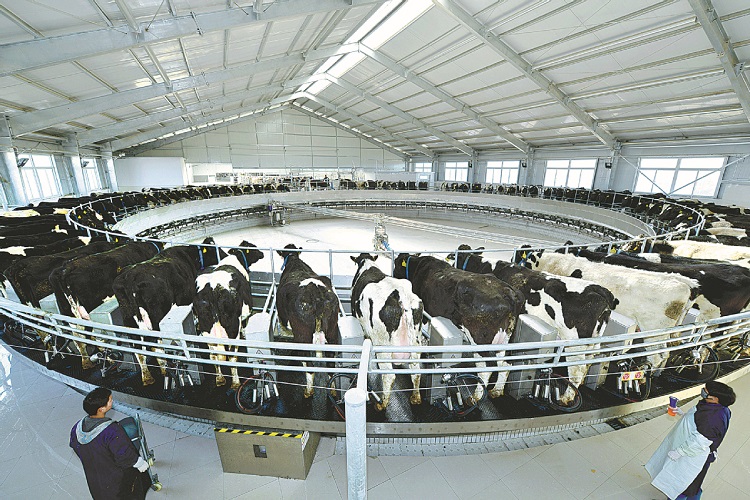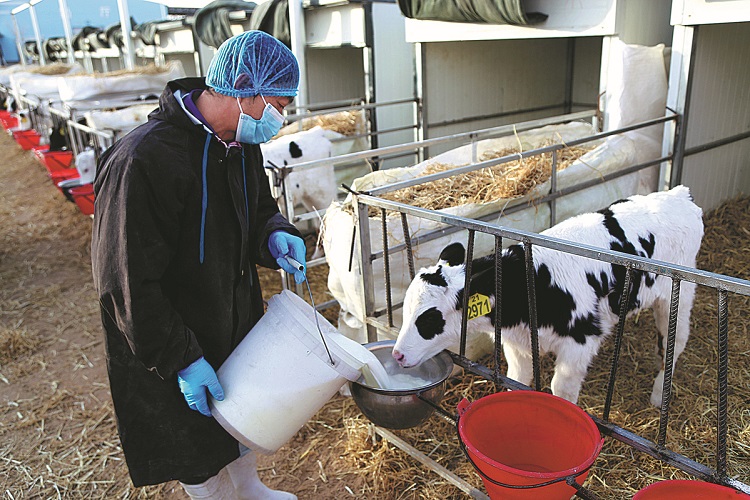
Dairy cows are tended to at a mechanized milking facility in Lingwu, Ningxia Hui autonomous region, in December. [Photo by peng Yaru/For China Daily]
Region looks to high-tech to become bigger player in milk products market
With its abundant sunshine and dry climate, the Ningxia Hui autonomous region has an advantage in breeding high-yield dairy cows. Now it hopes to further advance the high-end, high-tech development of its dairy sector.
This is happening as China aims to build a demonstration area for high-quality development and environmental protection in the Yellow River basin. Ningxia, in the upper reaches of the Yellow River, is seeing its dairy industry make steady progress toward the goal of achieving net sales revenue of 100 billion yuan ($15.77 billion) annually by 2026.
Ningxia Xin'ao Agriculture and Animal Husbandry Co Ltd in Yinchuan plans to integrate dairy production with tourism at its ranch, where it has more than 4,200 dairy cows. While investing 180 million yuan in the ranch, the company built sightseeing spots such as bridges, pavilions and terraces.
Visitors taking a sightseeing passageway at the ranch will be able to get a close-up view of the feeding of cattles and the complete milking process. They will also learn about cow feeding technologies and production of fresh milk through exhibitions.
Xin'ao plans to continue to build the ranch into a comprehensive environmental sightseeing venue that integrates processing of dairy products, tourism, exhibitions of dairy industry culture and sales of dairy products. Xin'ao said it expects the value of the company's annual production to reach 120 million yuan in 2021.
"In 2022, we expect to increase our cattle breeding, further lower production costs and reduce carbon emissions. We hope to overcome the challenges from increasing prices of raw materials as a result of the COVID-19 pandemic," said Yang Wenfei, president of Xin'ao.
Ningxia, which has become one of the main dairy production areas in China, began working on a comprehensive plan for cattle breeding in 2002. It has continued the programs, such as providing subsidies to farmers who foster superior breeds. It also standardized breeding operations at the national and regional levels and encouraged the low-carbon growth of the industry, local officials said.
In the past two years, the dairy sector in Ningxia implemented 130 projects and invested a total of 11.96 billion yuan. Total sales of the region's industrial chain reached 61 billion yuan, local officials said.
As of the end of November 2021, Ningxia had 355 large dairy farms, and 70 percent of them each had more than 1,000 head of cattle. In 2021, more than 99 percent of dairy production was large scale, significantly higher than the national average of 30 percent.
In the cities of Yinchuan, Shizuishan and Wuzhong in Ningxia, eight breeding centers, with each having a capacity of more than 20,000 head of cattle, have been built, local officials said.
Leading dairy companies are eager to participate in the growth. Mengniu Dairy Co Ltd, a major producer based in the Inner Mongolia autonomous region, is building the world's largest single processing plant for milk in Lingwu, Ningxia. In October 2022, the plant, encompassing an investment of 250 million yuan, is expected to begin operating with a daily processing capacity of 4,500 metric tons of fresh milk, company officials said.
Meanwhile, in Lingwu, the city government said it would continue to back the efforts of Ningxia Yimei Dairy Co Ltd, a local firm founded in 2007, to develop diversified dairy products besides fresh milk. Those products include condensed milk, cream, cheese and milk tea powder.
The company currently processes about 2,000 tons of fresh milk daily, including 1,200 tons it helps Mengniu process. The company is expanding its manufacturing plant, and the new facility is expected to be put into operation in the second half of 2022.
China's largest dairy company, Inner Mongolia Yili Industrial Group Co Ltd, has signed an agreement with Ningxia authorities to work together to set up a dairy industry chain business cluster. Ningxia identified the dairy industry as one of the nine key characteristic industries in the autonomous region, and it has proposed a new round of high-quality development plans.
By 2026, with the support of Yili Group, Ningxia aims to raise the region's dairy cow herd to 1.07 million, and increase raw milk output to 16,000 tons a year. By then, Ningxia aims to raise the total value of the local dairy industry chain's output to 100 billion yuan a year. The sector is expected to help drive the sustained and healthy economic growth of the autonomous region.
Ningxia has also been increasing its cooperation with a number of universities and scientific institutions to help advance the technological development of the local dairy sector.
A Wuzhong ranch has integrated cattle breeding with the 5G technologies in information management about fodder, reproduction and yields. Data summaries on a big screen monitor at the farm include information on herd sizes, such as the number of dairy cows.

A worker provides a calf with milk at a breeding base in Lingwu. [Photo by Peng Yaru/For China Daily]
"Dairy enterprises should build more smart facilities that are equipped with 5G networks, and further encourage industrial upgrading to integrate cattle breeding with the internet," said Ma Lie, general manager of Ningxia Woye Mufeng Agriculture and Animal Husbandry Co Ltd, a company founded in 2017 and recently listed on the National Equities Exchange and Quotations. The NEEQ is an over-the-counter system for trading shares of companies not listed on either the Shenzhen or Shanghai exchanges.
Shanghai-based dairy maker Bright Dairy, the municipal government of Zhongwei in Ningxia and Ningxia Agricultural Investment Co Ltd plan to join in building a dairy industry chain project.
The plans call for establishing a plant in Zhongwei to produce high-end organic infant formula and premium milk. It is expected to help fill the gap in high-end infant formula processing in Northwest China, according to Bright Dairy.
In addition, Ningxia Saishang Dairy Ltd said it provides about two-thirds of the whipped cream that coffee chain Starbucks uses nationwide. It also provides the raw materials for cheese caps-usually a layer of milk and cream cheese foam on top of tea-to Chinese boutique teahouse chain HeyTea.
"Only by turning Ningxia's high-quality milk into high value-added dairy products can we help the dairy sector in Ningxia to become a bigger player in the nationwide market," said Yan Jianguo, president of Ningxia Saishang Dairy.
Ningxia's government forecast that by the end of 2021, the autonomous region would have 673,000 cows, which would be 17.2 percent higher than in 2020.
The annual yield of milk per cow is expected to reach 9,200 kilograms, which would be significantly higher than the national average. The total annual output of fresh milk in the region would exceed 2.8 million tons, up 29.7 percent year-on-year, it said.